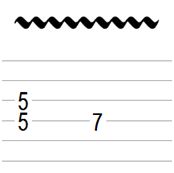By Tom Hess
Do your blues guitar licks lack musical expression because you are unable to simultaneously play them with both power and accuracy? Fact is, most guitarists have a hard time playing inspiring blues licks because they are unable to keep unused strings from ringing out (causing their licks to sound muddy and unclean). Before you can play highly self-expressive licks, you must solve this problem using proper muting technique.
For most guitarists, unwanted string noise frequently occurs while playing blues licks and using wide vibrato, double stops or extra power in the picking hand. You must master the ability to play cleanly while using these techniques, otherwise your blues guitar playing will never sound as self-expressive as you want it to.
For the rest of this article you will be taken through the exact steps needed for cleaning up unwanted string noise in your blues guitar licks. Before you read the steps in this article, check out this free video on the topic of how to play blues guitar licks so you can easily integrate the concepts of this article into your guitar playing:
After you’ve finished the video above, grab your guitar and complete these steps to make your blues guitar licks sound truly mean (without sacrificing cleanliness or accuracy).
Step One: Quickly create a new blues guitar lick containing a maximum of 2-3 notes. To give you some ideas to get started with, look at the examples below:
 |
 |
 |
| Blues Lick 1 | Blues Lick 2 | Blues Lick 3 |
It is very critical that you only create guitar licks with no more than three notes maximum. By using a limited number of notes, you will have no choice but to think creatively about achieving maximum expression in every note you play. This will help you become more musically expressive (increasing the quality of your licks). This is also important because it will help you focus on using proper muting technique to keep your phrases clean. Also observe how I did not notate the rhythm in the examples I provided for you. You are free to think creatively about the rhythms you use while playing these examples. Additionally, don’t play all of these licks at once, choose ONE and practice it many times until it becomes second nature. As you play through your lick, make sure the last note you play ends with an ‘upstroke’. You will see the importance of this in the next step.
Step Two: Pay close attention while using an upstroke to play the last note of your blues lick to make sure it comes to rest on the adjacent lower string. This uses the ‘rest stroke’ technique demonstrated in the video above. It is a common mistake to let the pick to come away from the strings while doing this, so make sure this is not occurring for you. To avoid this, rest your hand on the strings using either palm muting or thumb muting in your picking hand (I highly recommend you use thumb muting in the same way it is used in the video demonstration). Take several minutes to practice this.
Step Three: Now, use the available fingers of your fretting hand and picking hand to mute the strings that could be vibrating as you are playing the lick. If you are not sure how you should be doing this, check out this article about how to get rid of sloppy guitar string noise to see photos of how this is done correctly. Again, work on this for a few minutes before moving on to the next step.
Step Four: Add as much intensity to your lick as possible by performing any combination of the following sub-steps:
- Use very heavy vibrato to emphasize any sustained notes in your lick.
- While playing double stops, use heavy vibrato on both strings simultaneously.
- Use as much power as you can in your picking hand by using A LOT of force to strike the strings.
While using a lot of power to pick the notes, you will see the importance of muting with the techniques you learned in the previous steps. If you are still having issues with unwanted string noise, return to the previous steps to fix the problem. Don’t worry if you cannot play your licks perfectly without any string noise yet. Be patient, practice and you will quickly be able to incorporate your lick into your everyday guitar playing and make it sound great.
Step Five: Once you have mastered playing your lick with both power and accuracy (no excess string noise), think of 3-5 additional phrases and follow the previous steps to make many more killer blues licks.
Discover new ways to create more licks by checking out this free classic rock guitar licks video.
Find out how you can use speed to raise the intensity of your licks by watching this free guitar speed building video.
About The Author:
Tom Hess is a professional touring musician, composer and successful rock/metal guitar teacher. He helps guitarists around the world learn to play guitar online. On his website tomhess.net, you can find guitar playing tips, free guitar resources and more guitar articles.
Check out further free blues lessons on http://www.internet-guitar-lessons.com/blues-guitar.html
